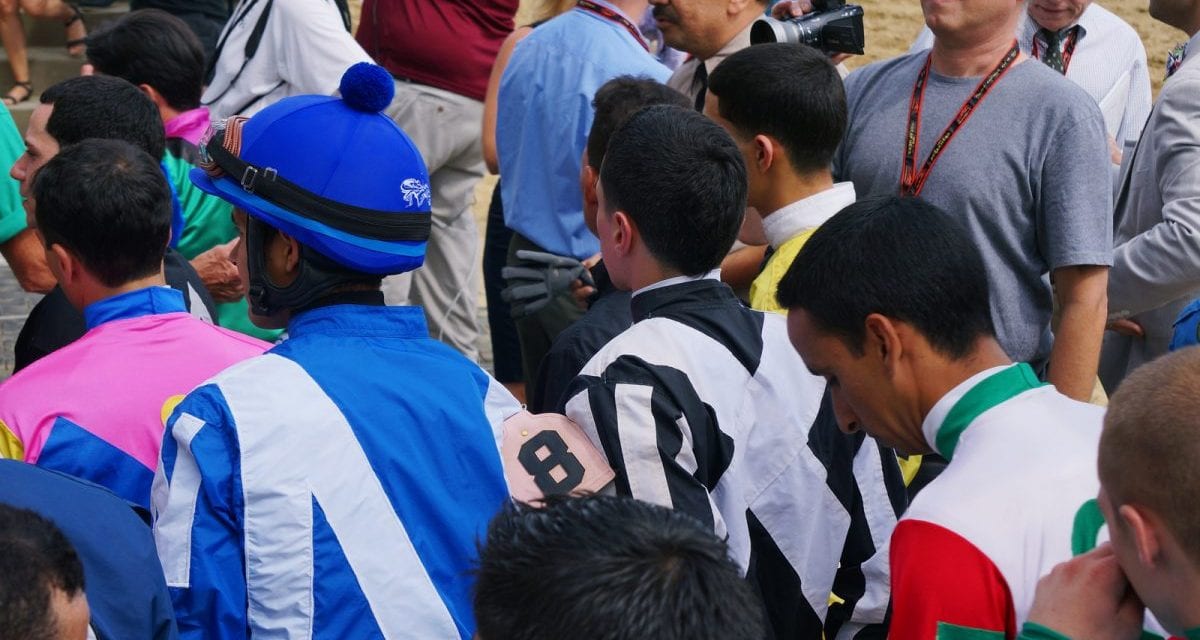In “Behind the numbers,” an occasional feature, we dig into racing data to see what’s really going on.

Steadying is one of a million ways horses can find trouble in a race; stumbling from the gate is another. Photo by Laurie Asseo.
It’s a staple of handicapping: reviewing past performances and charts to see which horses had trouble.
But what if trouble means different things at different tracks?
On the one hand, chart callers are trained to look at races in a certain way and employ certain terms consistently; on the other, they’re as human as the rest of us, as prone to biases, and — not unlike baseball umpires calling balls and strikes — faced with myriad judgment calls every day.
We reviewed a database including more than 28,000 starts from the beginning of 2013 through the present with a specific question: how often do horses have to steady? Steadying, of course, means breaking stride, slowing down, and represents one of the innumerable ways horses can have trouble during a race.
The answer was more intriguing than we realized.
The short answer is: horses in our database were recorded as steadying 2.67 percent of the time, or 748 times out 28,047.
The long answer is, well, longer.
For one thing, there are surface and distance variations. Horses on turf were considerably more likely to have to steady than those on dirt; they were recorded as having done so 3.72 percent of the time, versus just 2.35 percent of the time for horses on dirt. Presumably that stems from the differing ways in which dirt and turf races are typically run, with turf races often involving large packs running close together, and the larger fields prevalent on the grass.
There’s also a difference between sprint and route races. On dirt, horses steady in sprint races 2.49 percent of the time versus just 1.89 percent of the time in route races. Similarly, turf sprinters steady in 4.35 percent of starts, while turf routers do so only 3.45 percent of the time.
None of that is particularly surprising; more interesting are the differences from track to track.
Take the NYRA tracks for example (Aqueduct, Belmont, and Saratoga); in dirt races, those three tracks record steadies 0.97 percent, 0.25 percent, and 0.27 percent of the time, respectively. You might be inclined to think that a reflection of the relatively high quality of the jockey colony at those tracks. Not so fast, however; some other major league tracks, like Santa Anita, Gulfstream, and Churchill Downs all record significantly higher rates of steadying (2.89 percent, 3.24 percent, and 3.58 percent, respectively); all three, in fact, despite high quality jockey colonies, recorded higher-than-average rates of steadying.
What’s more, some tracks with relatively lower profile jockey colonies record very few incidents of steadying. At Penn National, for example, there were just four starters recorded as steadying out of 1,660 — just 0.24 percent, the lowest recorded of any track with at least 100 starters in the database. Delaware Park was another track where steadying was relatively rare; horses on dirt were listed as steadying 1.45 percent of the time there.
Those trends also follow on the turf; tracks with much lower than average rates of steadying on the dirt also had them on turf and vice versa. And again, the trend did not follow the perceived quality of the riders.
The trends are harder to track to riders because of the relative paucity of starts per rider. In our database, only nine riders had as many as 100 starts on the turf. Of those, the rider with the highest incidence of steadying was one widely considered among the region’s best grass riders: Horacio Karamanos, whose 167 recorded grass starts included 12 incidents of steadying (7.19 percent). The lowest was Edgar Prado, who steadied just once in 105 starts (0.95 percent); among mid-Atlantic riders, Xavier Perez steadied least frequently, twice in 122 starts, 1.64 percent.
On dirt, of the 11 riders with at least 200 starts in the database, Forest Boyce steadied 17 times from 338 starts — 5.03 percent of the time — to have the highest rate. The lowest in the mid-Atlantic (and second-lowest in the group) was Alex Cintron, who steadied twice in 244 starts (0.82 percent).
So, what does it all mean?
[show-rjqc id=”5″]On the one hand, it’s important to remember that this data doesn’t particularly prove anything. For one thing, a jockey and horse can get in trouble in many ways other than steadying — by ending up wide or engaging in a suicidal speed duel, for example. What’s more, a jockey who tries to shoot through tight holes may both win more and encounter more trouble than one who rides more cautiously.
On top of all that, different chart callers may describe trouble in different ways. In other words, one man’s “steadied” could be another man’s “stopped.”
Still, the data do point to some important reminders. First, as in life, everything’s relative; some chart callers will record more complete charts than others, and it’s worth knowing that some callers find trouble more liberally than others.
Second, the astute handicapper will do his or her own homework, and watching the races (or replays) is part of that. What’s on the page can help, but differences in circumstances and chart writing mean that a steady is not always a steady at all.
(Featured photo by Vas.)







